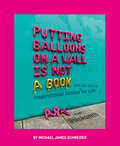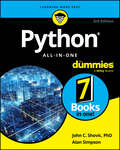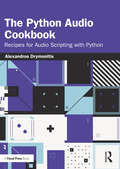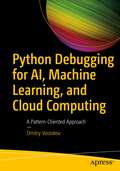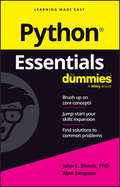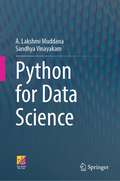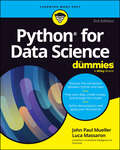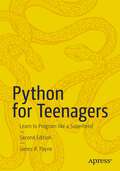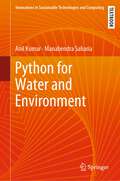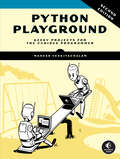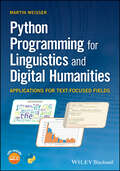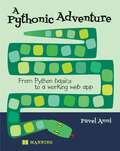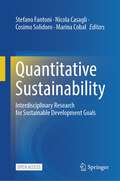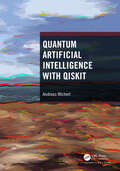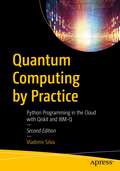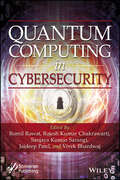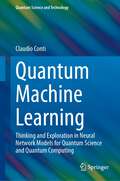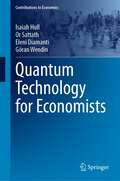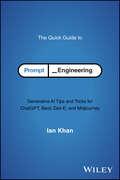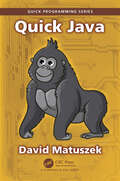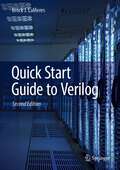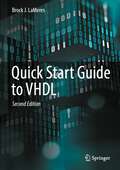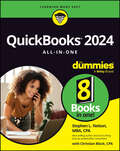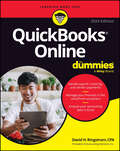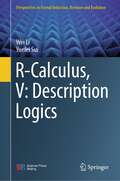- Table View
- List View
Putting Balloons on a Wall Is Not a Book: Inspirational Advice (and Non-Advice) for Life from @blcksmth
by Michael James SchneiderFrom viral balloon-word artist and Instagram sensation Michael James Schneider (@blcksmth) comes a one-of-a-kind debut gift book with never-before-seen original artwork!Featuring many of @blcksmth&’s most iconic balloon, flower, and light installations—plus exclusive new content—this book has a little something for everyone. Filled with funny, inspiring, and heartwarming messages on topics like self-love, self-growth, self-doubt, and advice for your future self, this is the perfect gift for any occasion or reader.
Python All-in-One For Dummies
by John C. Shovic Alan SimpsonEverything you need to know to get into Python coding, with 7 books in one Python All-in-One For Dummies is your one-stop source for answers to all your Python questions. From creating apps to building complex web sites to sorting big data, Python provides a way to get the work done. This book is great as a starting point for those new to coding, and it also makes a perfect reference for experienced coders looking for more than the basics. Apply your Python skills to data analysis, learn to write AI-assisted code using GitHub CoPilot, and discover many more exciting uses for this top programming language. Get started coding in Python—even if you’re new to computer programming Reference all the essentials and the latest updates, so your code is air-tight Learn how Python can be a solution for large-scale projects and big datasets Accelerate your career path with this comprehensive guide to learning PythonExperienced and would-be coders alike will love this easy-to-follow guide to learning and applying Python.
The Python Audio Cookbook: Recipes for Audio Scripting with Python
by Alexandros DrymonitisThe Python Audio Cookbook offers an introduction to Python for sound and multimedia applications, with chapters that cover writing your first Python programs, controlling Pyo with physical computing, and writing your own GUI, among many other topics. Guiding the reader through a variety of audio synthesis techniques, the book empowers readers to combine their projects with popular platforms, from the Arduino to Twitter, and state-of-the-art practices such as AI. The Python Audio Cookbook balances accessible explanations for theoretical concepts, including Python syntax, audio processing and machine learning, with practical applications. This book is an essential introductory guide to Python for sound and multimedia practitioners, as well as programmers interested in audio applications.
Python Debugging for AI, Machine Learning, and Cloud Computing: A Pattern-Oriented Approach
by Dmitry VostokovThis book is for those who wish to understand how Python debugging is and can be used to develop robust and reliable AI, machine learning, and cloud computing software. It will teach you a novel pattern-oriented approach to diagnose and debug abnormal software structure and behavior. The book begins with an introduction to the pattern-oriented software diagnostics and debugging process that, before performing Python debugging, diagnoses problems in various software artifacts such as memory dumps, traces, and logs. Next, you’ll learn to use various debugging patterns through Python case studies that model abnormal software behavior. You’ll also be exposed to Python debugging techniques specific to cloud native and machine learning environments and explore how recent advances in AI/ML can help in Python debugging. Over the course of the book, case studies will show you how to resolve issues around environmental problems, crashes, hangs, resource spikes, leaks, and performance degradation. This includes tracing, logging, and analyziing memory dumps using native WinDbg and GDB debuggers. Upon completing this book, you will have the knowledge and tools needed to employ Python debugging in the development of AI, machine learning, and cloud computing applications. What You Will Learn Employ a pattern-oriented approach to Python debugging that starts with diagnostics of common software problemsUse tips and tricks to get the most out of popular IDEs, notebooks, and command-line Python debuggingUnderstand Python internals for interfacing with operating systems and external modulesPerform Python memory dump analysis, tracing, and logging Who This Book Is For Software developers, AI/ML engineers, researchers, data engineers, as well as MLOps and DevOps professionals.
Python Essentials For Dummies
by John C. Shovic Alan SimpsonThe no-nonsense way to get started coding in the Python programming language Python Essentials For Dummies is a quick reference to all the core concepts in Python, the multifaceted general-purpose language used for everything from building websites to creating apps. This book gets right to the point, with no excess review, wordy explanations, or fluff, making it perfect as a desk reference on the job or as a brush-up as you expand your skills in related areas. Focusing on just the essential topics you need to know to brush up or level up your Python skill, this is the reliable little book you can always turn to for answers. Get a quick and thorough intro to the basic concepts of coding in Python Review what you've already learned or pick up essential new skills Create websites, software, machine learning, and automation for school or work Keep this concise reference book handy for jogging your memory as you code This portable Dummies Essentials book focuses on the key topics you need to know about the popular Python language. Great for supplementing a course, reviewing for a certification, or staying knowledgeable on the job.
Python for Data Science
by A. Lakshmi Muddana Sandhya VinayakamThe book is designed to serve as a textbook for courses offered to undergraduate and graduate students enrolled in data science. This book aims to help the readers understand the basic and advanced concepts for developing simple programs and the fundamentals required for building machine learning models. The book covers basic concepts like data types, operators, and statements that enable the reader to solve simple problems. As functions are the core of any programming, a detailed illustration of defining & invoking functions and recursive functions is covered. Built-in data structures of Python, such as strings, lists, tuples, sets, and dictionary structures, are discussed in detail with examples and exercise problems. Files are an integrated part of programming when dealing with large data. File handling operations are illustrated with examples and a case study at the end of the chapter. Widely used Python packages for data science, such as Pandas, Data Visualization libraries, and regular expressions, are discussed with examples and case studies at the end of the chapters. The book also contains a chapter on SQLite3, a small relational database management system of Python, to understand how to create and manage databases. As AI applications are becoming popular for developing intelligent solutions to various problems, the book includes chapters on Machine Learning and Deep Learning. They cover the basic concepts, example applications, and case studies using popular frameworks such as SKLearn and Keras on public datasets
Python for Data Science For Dummies
by John Paul Mueller Luca MassaronLet Python do the heavy lifting for you as you analyze large datasets Python for Data Science For Dummies lets you get your hands dirty with data using one of the top programming languages. This beginner’s guide takes you step by step through getting started, performing data analysis, understanding datasets and example code, working with Google Colab, sampling data, and beyond. Coding your data analysis tasks will make your life easier, make you more in-demand as an employee, and open the door to valuable knowledge and insights. This new edition is updated for the latest version of Python and includes current, relevant data examples. Get a firm background in the basics of Python coding for data analysis Learn about data science careers you can pursue with Python coding skills Integrate data analysis with multimedia and graphics Manage and organize data with cloud-based relational databasesPython careers are on the rise. Grab this user-friendly Dummies guide and gain the programming skills you need to become a data pro.
Python for Teenagers: Learn to Program like a Superhero!
by James R. PayneThis book, which is designed for middle-school through college-aged students, will arm beginners with solid programming foundations they can carry throughout life. It uses fun and simple language (and programming examples) to teach the fundamentals needed to start the down path of becoming a programmer. Python is a highly flexible language, allowing developers to enter any number of technical fields and is a welcome addition to any resume. With its low learning curve, it makes a great introductory language, as new developers can take the coding fundamentals they learn in Python and apply them to any other language. The second edition builds upon the foundation of the first book, revising all the chapters where the language has changed, updating the commands, code, and examples to bring it up to date with the current version of Python. Since Python is the most popular programming language in the world and can be used in conjunction with other languages - across multiple platforms - it can increase the reader's ability to qualify for a wider range of jobs than other languages. Finally, Python is fun - something not every programming language can boast! What You Will Learn Install and configure PythonGrasp basic software development principles and syntaxUnderstand the best practices for coding in PythonCreate applications and debug code Who This Book Is For The book’s target audience is primarily middle school to college aged students looking to learn how to program computers and develop software. Older individuals and computer programmers who know other languages and want to add Python to their repertoire can also benefit from the book.
Python for Water and Environment (Innovations in Sustainable Technologies and Computing)
by Anil Kumar Manabendra SahariaThis textbook delves into the practical applications of surface and groundwater hydrology, as well as the environment. The Part I, "Practical Python for a Water and Environment Professional," guides readers through setting up a scientific computing environment and conducting exploratory data analysis and visualization using reproducible workflows. The Part II, "Statistical Modeling in Hydrology," covers regression models, time series analysis, and common hypothesis testing. The Part III, "Surface and Subsurface Water," illustrates the use of Python in understanding key concepts related to seepage, groundwater, and surface water flows. Lastly, the Part IV, "Environmental Applications," demonstrates the application of Python in the study of various contaminant transport phenomena.
Python Playground, 2nd Edition: Geeky Projects for the Curious Programmer
by Mahesh VenkitachalamPut the fun back in Python programming and build your skills as you create 3D simulations and graphics, speech-recognition machine-learning systems, IoT devices, and more.The fully updated 2nd edition is here, now with 5 brand-new projects!Harness the power of Python as you turn code into tangible creations with Python Playground, a collection of 15 inventive projects that will expand your programming horizons, spark your curiosity, and elevate your coding skills.Go beyond the basics as you write programs to generate art and music, simulate real-world phenomena, and interact with hardware, all through the use of Python and common libraries such as numpy, matplotlib, and Pillow.As you work through the book&’s projects, you will:Craft intricate Spirograph-like designs with parametric equations and the turtle moduleGenerate music by synthesizing plucked string soundsTransform everyday images into ASCII art, photomosaics, and eye-popping autostereogramsDesign engaging cellular automata and flocking simulationsExplore the realm of 3D graphics, from basic shape rendering to visualizing MRI scan dataBuild a Raspberry Pi–powered laser show that dances along with musicNew to this edition: We&’ve expanded your playground with five new projects: you&’ll draw fractals, bring Conway&’s Game of Life into 3D space, and use a Raspberry Pi and Python to create a musical instrument, an IoT garden monitor, and even a machine learning–driven speech recognition system.Whether you&’re a seasoned professional or just getting started, you&’ll find Python Playground to be a great way to learn, experiment with, and master this versatile programming language.Covers Python 3.x
Python Programming for Linguistics and Digital Humanities: Applications for Text-Focused Fields
by Martin WeisserLearn how to use Python for linguistics and digital humanities research, perfect for students working with Python for the first time Python programming is no longer only for computer science students; it is now an essential skill in linguistics, the digital humanities (DH), and social science programs that involve text analytics. Python Programming for Linguistics and Digital Humanities provides a comprehensive introduction to this widely used programming language, offering guidance on using Python to perform various processing and analysis techniques on text. Assuming no prior knowledge of programming, this student-friendly guide covers essential topics and concepts such as installing Python, using the command line, working with strings, writing modular code, designing a simple graphical user interface (GUI), annotating language data in XML and TEI, creating basic visualizations, and more. This invaluable text explains the basic tools students will need to perform their own research projects and tackle various data analysis problems. Throughout the book, hands-on exercises provide students with the opportunity to apply concepts to particular questions or projects in processing textual data and solving language-related issues. Each chapter concludes with a detailed discussion of the code applied, possible alternatives, and potential pitfalls or error messages. Teaches students how to use Python to tackle the types of problems they will encounter in linguistics and the digital humanities Features numerous practical examples of language analysis, gradually moving from simple concepts and programs to more complex projects Describes how to build a variety of data visualizations, such as frequency plots and word clouds Focuses on the text processing applications of Python, including creating word and frequency lists, recognizing linguistic patterns, and processing words for morphological analysis Includes access to a companion website with all Python programs produced in the chapter exercises and additional Python programming resourcesPython Programming for Linguistics and Digital Humanities: Applications for Text-Focused Fields is a must-have resource for students pursuing text-based research in the humanities, the social sciences, and all subfields of linguistics, particularly computational linguistics and corpus linguistics.
A Pythonic Adventure: From Python basics to a working web app
by Pavel AnniTime to take an adventure with friends! Team up with Erik and Simon to learn Python the easy way. This colorful book uses engaging questions and lively conversations to introduce computer programming to young readers one step at a time.In A Pythonic Adventure, you will learn useful Python skills like: Installing Python Working with files Creating text-based dialogs and menus Using if/then, loops, lists, dictionaries, and input/output Building web applications Making your web apps look super professional It&’s fun to learn with friends! In A Pythonic Adventure you&’ll meet Erik and Simon, two brothers who are just beginning their Python journey. Join them as they chat about the language, learn the basics, and build some cool programs. The book&’s dialogue helps young programmers understand complex concepts much more easily. It's the perfect way for young programmers (and their parents) to get started. There&’s no boring lessons or dull exercises in this adventure. You&’ll follow Erik and Simon&’s questions and mistakes, discover how to write programs with a team, and get a chance to create applications you can use in your daily life. By the time they&’re done reading, young learners will not only know how to write code, they&’ll know how to think about problems like professional developers. All code in this book runs on Mac, Windows, Linux, and Raspberry Pi. About the technology Computer programming is an adventure, full of new experiences, challenges, triumphs, and mistakes. In A Pythonic Adventure, you&’ll join brothers Erik and Simon as they learn to create their first Python program. Written especially for young readers, this book is the perfect introduction to a skill that will last a lifetime! About the book A Pythonic Adventure teaches you to code by asking questions, making errors, and trying out different solutions—just like in real life. As you go, you&’ll create a web application for a coffee shop step-by-step, from your first online menu to saving orders in a database. And this unique tutorial goes deeper than other beginner books. You&’ll learn and practice important skills like planning applications, finding bugs, and managing user expectations. What's inside Installing Python Creating text-based dialogs and menus Building web applications Making your web apps look professional About the reader For readers aged 10+. Perfect for adult beginners, too! About the author Pavel Anni is a Principal Customer Engineer at SambaNova Systems, and has also worked for Sun Microsystems, Oracle, and Red Hat. Table of Contents 1 Coffee for friends: First steps 2 Lists: What&’s on the menu? 3 Functions: Don&’t repeat yourself! 4 User errors: Everybody makes mistakes 5 Working with files: Being a shop manager 6 Main menu: Next customer! 7 Creating functions: Get the order and print it 8 Working with JSON: Save the order 9 Complete the menu: A real program 10 Learning Flask: Your first web application 11 Web form for orders: Coffee shop on the web 12 Database: We need good storage 13 Styles: Making it pretty 14 Help from AI: Improving our code 15 Next steps: Plans for the future
Quantitative Sustainability: Interdisciplinary Research for Sustainable Development Goals
by Stefano Fantoni Nicola Casagli Cosimo Solidoro Marina CobalThis open access book focuses on how scientific methodologies can help industrial managers, entrepreneurs and policymakers handle the 17 Sustainable Development Goals in an efficient and realistic way. It also offers an operative scheme for scientists to overcome their discipline barriers. Is interdisciplinarity an intrinsic research value or is it merely instrumental for handling the increasing flux of open problems that sustainability poses to science?Can these problems of sustainability be solved with what the authors already know? Is it just a matter of having the right people at the table and giving them sufficient resources, or is it something more? Is meeting the needs of the present without compromising those of future generations a scientific definition of sustainable development? Questions similar to those posed in the sixties regarding complexity must be asked about sustainability today. In addition, the new data science includes powerful tools for making novel quantitative predictions about future sustainability indicators, an open problem that the book discusses. This book is primarily addressed to Ph.D. students, postdocs and senior researchers in the Life and Hard Science (LHS) and Social Sciences and Humanities (SSH) disciplines, as well as professionals of the primary, secondary and tertiary industrial sectors.
Quantum Artificial Intelligence with Qiskit
by Andreas WichertQuantum Artificial Intelligence (QAI) is a new interdisciplinary research field that combines quantum computing with Artificial Intelligence (AI), aiming to use the unique properties of quantum computers to enhance the capabilities of AI systems. Quantum Artificial Intelligence with Qiskit provides a cohesive overview of the field of QAI, providing the tools for readers to create and manipulate quantum programs on devices as accessible as a laptop computer. Introducing symbolical quantum algorithms, sub-symbolical quantum algorithms, and quantum Machine Learning (ML) algorithms, this book explains each process step by step with associated Qiskit listings. All examples are additionally available for download at https://github.com/andrzejwichert/qai. Allowing readers to learn the basic concepts of quantum computing on their home computers, this book is accessible to both the general readership as well as students and instructors of courses relating to computer science and AI.
Quantum Computing by Practice: Python Programming in the Cloud with Qiskit and IBM-Q
by Vladimir SilvaLearn to write algorithms and program in the new field of quantum computing. This second edition is updated to equip you with the latest knowledge and tools needed to be a complex problem-solver in this ever-evolving landscape. The book has expanded its coverage of current and future advancements and investments by IT companies in this emerging technology. Most chapters are thoroughly revised to incorporate the latest updates to IBM Quantum's systems and offerings, such as improved algorithms, integrating hardware advancements, software enhancements, bug fixes, and more. You’ll examine quantum computing in the cloud and run experiments there on a real quantum device. Along the way you’ll cover game theory with the Magic Square, an example of quantum pseudo-telepathy. You’ll also learn to write code using QISKit, Python SDK, and other APIs such as QASM and execute it against simulators (local or remote) or a real quantum computer. Then peek inside the inner workings of the Bell states for entanglement, Grover’s algorithm for linear search, Shor’s algorithm for integer factorization, and other algorithms in the fields of optimization, and more. Finally, you’ll learn the current quantum algorithms for entanglement, random number generation, linear search, integer factorization, and others. By the end of this book, you’ll understand how quantum computing provides massive parallelism and significant computational speedups over classical computersWhat You'll LearnWrite algorithms that provide superior performance over their classical counterpartsCreate a quantum number generator: the quintessential coin flip with a quantum twistExamine the quantum algorithms in use today for random number generation, linear search, and moreDiscover quantum teleportationHandle the counterfeit coin problem, a classic puzzle Put your knowledge to the test with more than 150 practice exercises Who This Book Is ForDevelopers, programmers, computer science researchers, teachers, and students.
Quantum Computing in Cybersecurity
by Romil Rawat Rajesh Kumar Chakrawarti Sanjaya Kumar Sarangi Jaideep Patel Vivek Bhardwaj Anjali Rawat Hitesh RawatMachine learning, deep learning, probabilistic neural networks, blockchain, and other new technologies all demand extremely high processing speeds. A quantum computer is an example of such a system. Quantum computers may be accessed over the internet. This technology poses a significant risk, since quantum terrorists, or cyber criminals, coul be able to cause many problems, including bringing down the internet. The principles of quantum mechanics might be used by evil doers to destroy quantum information on a global scale, and an entire class of suspicious codes could destroy data or eavesdrop on communication. Quantum physics, however, safeguards against data eavesdropping. A significant amount of money is being invested in developing and testing a quantum version of the internet that will eliminate eavesdropping and make communication nearly impenetrable to cyber-attacks. The simultaneous activation of quantum terrorists (organized crime) can lead to significant danger by attackers introducing quantum information into the network, breaking the global quantum state, and preventing the system from returning to its starting state. Without signs of identifying information and real-time communication data, such vulnerabilities are very hard to discover. Terrorists' synchronized and coordinated acts have an impact on security by sparking a cyber assault in a fraction of a second. The encryption is used by cyber-criminal groups with the genuine, nefarious, and terrible motives of killing innocent people or stealing money. In the hands of criminals and codes, cryptography is a dangerous and formidable weapon. Small amounts of digital information are hidden in a code string that translates into an image on the screen, making it impossible for the human eye to identify a coded picture from its uncoded equivalents. To steal the cryptographic key necessary to read people's credit card data or banking information, cyber thieves employ installed encryption techniques, human mistakes, keyboard loggers, and computer malware. This new volume delves into the latest cutting-edge trends and the most up-to-date processes and applications for quantum computing to bolster cybersecurity. Whether for the veteran computer engineer working in the field, other computer scientists and professionals, or for the student, this is a one-stop-shop for quantum computing in cyber security and a must have for any library.
Quantum Machine Learning: Thinking and Exploration in Neural Network Models for Quantum Science and Quantum Computing (Quantum Science and Technology)
by Claudio ContiThis book presents a new way of thinking about quantum mechanics and machine learning by merging the two. Quantum mechanics and machine learning may seem theoretically disparate, but their link becomes clear through the density matrix operator which can be readily approximated by neural network models, permitting a formulation of quantum physics in which physical observables can be computed via neural networks. As well as demonstrating the natural affinity of quantum physics and machine learning, this viewpoint opens rich possibilities in terms of computation, efficient hardware, and scalability. One can also obtain trainable models to optimize applications and fine-tune theories, such as approximation of the ground state in many body systems, and boosting quantum circuits’ performance. The book begins with the introduction of programming tools and basic concepts of machine learning, with necessary background material from quantum mechanics and quantum information also provided. This enables the basic building blocks, neural network models for vacuum states, to be introduced. The highlights that follow include: non-classical state representations, with squeezers and beam splitters used to implement the primary layers for quantum computing; boson sampling with neural network models; an overview of available quantum computing platforms, their models, and their programming; and neural network models as a variational ansatz for many-body Hamiltonian ground states with applications to Ising machines and solitons. The book emphasizes coding, with many open source examples in Python and TensorFlow, while MATLAB and Mathematica routines clarify and validate proofs. This book is essential reading for graduate students and researchers who want to develop both the requisite physics and coding knowledge to understand the rich interplay of quantum mechanics and machine learning.
Quantum Technology for Economists (Contributions to Economics)
by Isaiah Hull Or Sattath Eleni Diamanti Göran WendinThis book offers an introduction to quantum technology that is specifically tailored to economists, students of economics, and professionals in the financial and payments industries. The book reviews quantum speedups that have been identified for algorithms used to solve and estimate economic models, including function approximation, linear systems analysis, graphical modeling, Monte Carlo simulation, matrix inversion, principal component analysis, linear regression, dynamic programming, interpolation, numerical differentiation, and true random number generation. It also provides an overview of quantum financial technology and its potential applications in economics and finance. Written by an interdisciplinary team with backgrounds in economics, computer science, and physics, this book offers a valuable guide for researchers and practitioners who want to understand the implications and possibilities of quantum technology for the field of economics.
The Quick Guide to Prompt Engineering: Generative AI Tips and Tricks for ChatGPT, Bard, Dall-E, and Midjourney
by Ian KhanDesign and use generative AI prompts that get helpful and practical results In The Quick Guide to Prompt Engineering, renowned technology futurist, management consultant, and AI thought leader Ian Khan delivers a practical and insightful discussion on taking the first steps in understanding and learning how to use generative AI. In this concise and quick start guide, you will learn how to design and use prompts to get the most out of Large Language Model generative AI applications like ChatGPT, DALL-E, Google’s Bard, and more. In the book, you’ll explore how to understand generative artificial intelligence and how to engineer prompts in a wide variety of industry use cases. You’ll also find thoughtful and illuminating case studies and hands-on exercises, as well as step-by-step guides, to get you up to speed on prompt engineering in no time at all. The book has been written for the non-technical user to take the first steps in the world of generative AI. Along with a helpful glossary of common terms, lists of useful additional reading and resources, and other resources, you’ll get: Explanations of the basics of generative artificial intelligence that help you to learn what’s going on under the hood of ChatGPT and other LLMs Stepwise guides to creating effective, efficient, and ethical prompts that help you get the most utility possible from these exciting new tools Strategies for generating text, images, video, voice, music, and other audio from various publicly available artificial intelligence tools Perfect for anyone with an interest in one of the newest and most practical technological advancements recently released to the public, The Quick Guide to Prompt Engineering is a must-read for tech enthusiasts, marketers, content creators, technical professionals, data experts, and anyone else expected to understand and use generative AI at work or at home. No previous experience is required.
Quick Java (Quick Programming)
by David Matuszek"We’ll be doing this next project in Java." Unfortunately, you’re a C++ programmer, or maybe a Python programmer. How are you going to get up to speed in a hurry? There are lots of Java books for beginners, telling you all about what a computer is and how it represents everything in bits. You don’t need that. At the other extreme, there are thousand-page tomes that you aren’t going to get through in a few days, if ever. You need something in-between. This book is intended to fill that gap. It’s written for the programmer who doesn’t need to be taught how to program, just how to do it in Java—and who needs to get started in a hurry. Java is covered from the inside out. First, all the things that go inside a class, most of which are practically identical to C++. After that, all the various and complicated kinds of classes and interfaces and how they relate to each other in large-scale programs. Testing is essential, so (unlike most Java books) JUnit is covered in detail. Then, in case you need to go in that direction, some functional programming, a little about parallel programming, and more than enough to get you started in building GUIs (graphical user interfaces) and doing animation. There’s a lot in this little book and, despite my best efforts, you won’t learn Java in a weekend. But it should be a good start. FEATURES Circular approach allows very fast entry into Java Full description of JUnit testing Summary of functional programming in Java Introduction to synchronization and parallel processing Extensive description of building GUIs
Quick Start Guide to Verilog
by Brock J. LaMeresThis textbook provides a starter’s guide to Verilog, to be used in conjunction with a one-semester course in Digital Systems Design, or on its own for readers who only need an introduction to the language. This book is designed to match the way the material is actually taught in the classroom. Topics are presented in a manner which builds foundational knowledge before moving onto advanced topics. The author has designed the presentation with learning goals and assessment at its core. Each section addresses a specific learning outcome that the student should be able to “do” after its completion. The concept checks and exercise problems provide a rich set of assessment tools to measure student performance on each outcome.Written the way the material is taught, enabling a bottom-up approach to learning which culminates with a high-level of learning, with a solid foundation;Emphasizes examples from which students can learn: contains a solved example for nearly every section in the book;Includes more than 200 exercise problems, as well as concept check questions for each section, tied directly to specific learning outcomes.
Quick Start Guide to VHDL
by Brock J. LaMeresThis textbook provides a starter’s guide to VHDL. This book can be used in conjunction with a one-semester course in Digital Systems Design or on its own for designers who only need an introduction to the language. This book is designed to provide a bottoms-up approach to learning the VHDL language. This design supports a course in which foundational knowledge is covered before moving into advanced topics. However, this design also supports use as a reference manual. The author has designed the presentation with learning goals and assessment at its core. Each section addresses a specific learning outcome that the student should be able to “do” after its completion. The concept checks and exercise problems provide a rich set of assessment tools to measure student performance on each outcome.
QuickBooks 2024 All-in-One For Dummies
by Stephen L. NelsonThe quick way to get started—and get proficient—with QuickBooks QuickBooks 2024 All-in-One For Dummies is the solution small business owners and managers are seeking. This high-value reference combines 8 content-rich mini-books into one complete package, providing the answers you need to get the most out of the 2024 version of QuickBooks. You’ll learn the key features of QuickBooks and small business accounting, including setting up the software, understanding double-entry bookkeeping, invoicing customers, paying vendors, tracking inventory, creating reports, and beyond. Plus, you’ll discover how you can use cloud storage to access your information on your smartphone, making running a small business that much more manageable. Sign up for QuickBooks software, set up your accounts, and customize your preferences Learn the basics of accounting and bookkeeping, and make sure you’re doing it right Discover advanced features of QuickBooks that will help you run your business smoothly and efficiently Save money by confidently managing your finances yourself This beginner-friendly Dummies guide makes it a breeze for small business owners, managers, and employees to implement QuickBooks at work.
QuickBooks Online For Dummies
by David H. RingstromLearn the world’s most popular cloud accounting platform QuickBooks Online For Dummies, 2024 Edition, helps you benefit from fast and easy mobile accounting. This beginner-friendly guide covers the key features of QuickBooks Online, including selecting the subscription version that’s right for you and your business -- Simple Start, Plus, or Advanced. From there, you’ll find everything you need to get started creating invoices and credit memos, recording and paying bills, setting up inventory items, processing payroll and preparing payroll tax returns, balancing accounts, and beyond. You’ll discover how to access your accounts from any device, anywhere—and how to keep your data safe and backed up. For a world on the go, QuickBooks Online makes it easy to keep solid books and be prepared at tax time. With the clear how-tos in this book, you’ll be up and running in no time. Get started with QuickBooks Online and set up your accounts Manage customers, inventory, purchases, payroll, and billing—from anywhere Generate financial reports and simplify your taxes Discover new features and tips in the latest version of the cloud softwareFor small business owners, managers, and employees responsible for business accounting, QuickBooks Online For Dummies helps you make the most of the go-to platform for fluid accounting access.
R-Calculus, V: Description Logics (Perspectives in Formal Induction, Revision and Evolution)
by Wei Li Yuefei SuiThis book series consists of two parts, decidable description logics and undecidable description logics. It gives the R-calculi for description logics. This book offers a rich blend of theory and practice. It is suitable for students, researchers and practitioners in the field of logic.
